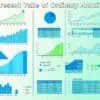Are you new to investing? It is probably best to practice with fake money before you start with real money. Paper trading is great for that. You’ll learn and get better with it before you actually start trading with real money.

Paper trading feels like the real stock market. It’s definitely a safe way to learn about investing and get used to the market.
Key Takeaways
- Paper trading is a simulated investing technique
- The accounts mimic real brokerage accounts without using real money
- You can test strategies, build confidence, and track performance with paper trading
- Paper trading is a way to prepare for live trading
What Is Paper Trading?
Paper trading is a term that the investment industry uses in the process of learning how to trade. It lets you practice buying and selling without real money. It’s a safe way to try out strategies and learn about the market.
Definition of Paper Trading
The money Paper trading uses isn’t real. It only mimics real market trades. You’re able to create a portfolio and track your trades, just like with real trading. This way, you can learn and get better without losing real money.
Origins of the Term “Paper Trading”
The term “paper trading” started when traders wrote down fake trades on paper. This helped them test ideas without losing money. With all the new digital tools, it is even easier to practice trading.
Today’s paper trading platforms have lots of tools like real-time data and charts. All these tools help you learn and improve your trading skills.
How Paper Trades Work
Paper trading isn’t difficult to get into! Here’s some quick info to help you start and make the most of your practice trades.
Setting Up a Paper Trading Account
To start paper trading, you’ll need an account. Usually, getting a paper trading account is easy. You’ll need to give some basic info like your name and email.
Placing Simulated Trades
With your account ready, you can start trading in the virtual stock market. Trading in a paper account is like trading with real money. You look for stocks, analyze data, and decide when to buy or sell.

It’s key to treat paper trades like real ones. Think about market conditions, company info, and your strategy. This way, you’ll be ready for real trading later.
Tracking Your Portfolio Performance
It’s important to watch how your trades do. Most platforms have tools to help you see how you’re doing. You can check your balance, diversification, risk, and more.
- Account balance and profit/loss statements
- Portfolio diversification and asset allocation
- Risk management metrics, such as volatility and drawdown
- Performance charts and graphs
By checking your performance often, you can improve. You’ll learn how your trades would do in real markets. This builds your confidence as a trader.
By trading in a paper account, you’ll get better. This will help you succeed in the real stock market.
Pros and Cons of Paper Trading
- No risk of losing real money
- Allows new and experienced investors to practice
- Investors can test and choose strategies
- Isn’t perfect
- There is a chance of false sense of security
- No chance of getting real returns
- Strategies are more challenging in live trading
Paper trading is great for new and experienced investors. It lets you practice in a safe way. This helps you learn and get better at trading.
Learning the Ropes Without Risk
One big plus of paper trading is learning without losing money. Beginners can get to know investing basics safely. You can try different things without worrying about losing money.
This safe space lets you make mistakes and learn from them. You can slowly get better at trading.
Strategies and Techniques
Paper trading is great for trying out trading plans you might have. See what works best for you.
By looking at your fake trades, you can spot patterns. You can also improve how you start and end trades. This helps you make a strong trading plan.
Building Confidence in Your Trading Abilities
As you practice, you’ll feel more sure about trading. Seeing your plans work in fake markets helps. It makes you feel more comfortable with trading.
This confidence is key when you start trading for real. It helps you stay focused and manage your feelings when things get tough.
Paper Trading vs. Live Trading
Paper trading is great for learning, no doubt. But, knowing the difference between it and live trading is very important. When you start trading with real money, many things change. These changes can affect how you make decisions and how well you trade.
Key Differences Between Paper and Live Trading
The main difference is that live trading uses real money. This means you could lose money and face real consequences. This pressure can make you feel different emotions than when you’re just practicing.
Also, live trading has costs like fees and commissions. These can lower your profits.
Psychological Factors in Live Trading
Emotions are big in live trading because you can win or lose real money. Fear and greed are common feelings. Fear might make you hesitate or get out too soon. Greed can make you trade too much or hold onto bad trades.
These feelings can mess with your thinking and make you stray from your plan.
Transitioning from Paper to Live Trading
Starting to trade with real money should be done slowly. Start with a small amount and use what you learned from paper trading. As you get better, you can trade more money.
Always stay disciplined and follow your plan. Keep learning and adjusting based on how you do and the market.
FAQ
It’s a way to practice buying and selling stocks without losing real money.
First, you need to create a paper trading account on a popular platform. Then, you can make fake trades with virtual money. You’ll use tools to see how your portfolio does.
Great for beginners
Learn investing without risking real money
You can try different strategies
Builds your confidence in trading
It prepares you for trading with real money
No. Live trading involves real money. Paper trading doesn’t.
Start by feeling confident in your paper trading skills. Then, begin with a small amount of real money. Practice managing risks.
Remember, live trading is different. Emotions and real money risks can change your decisions. Be ready to adjust your strategies. Always keep learning from your experiences.











